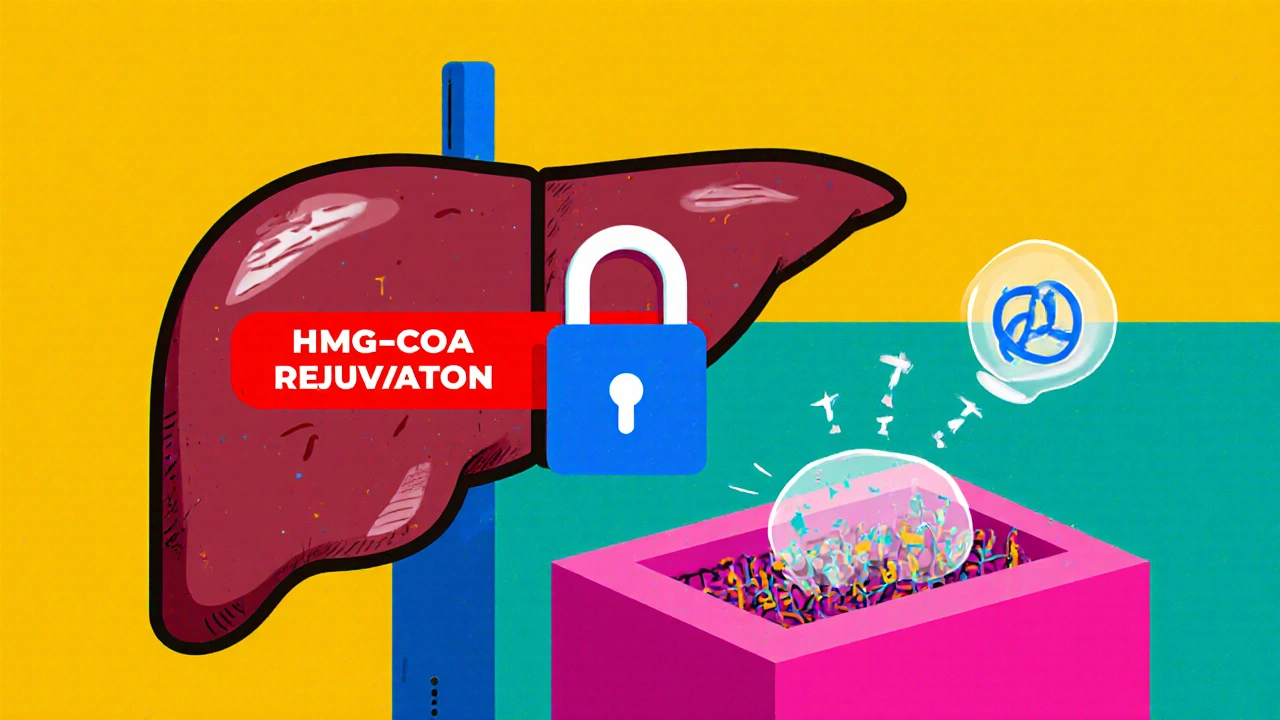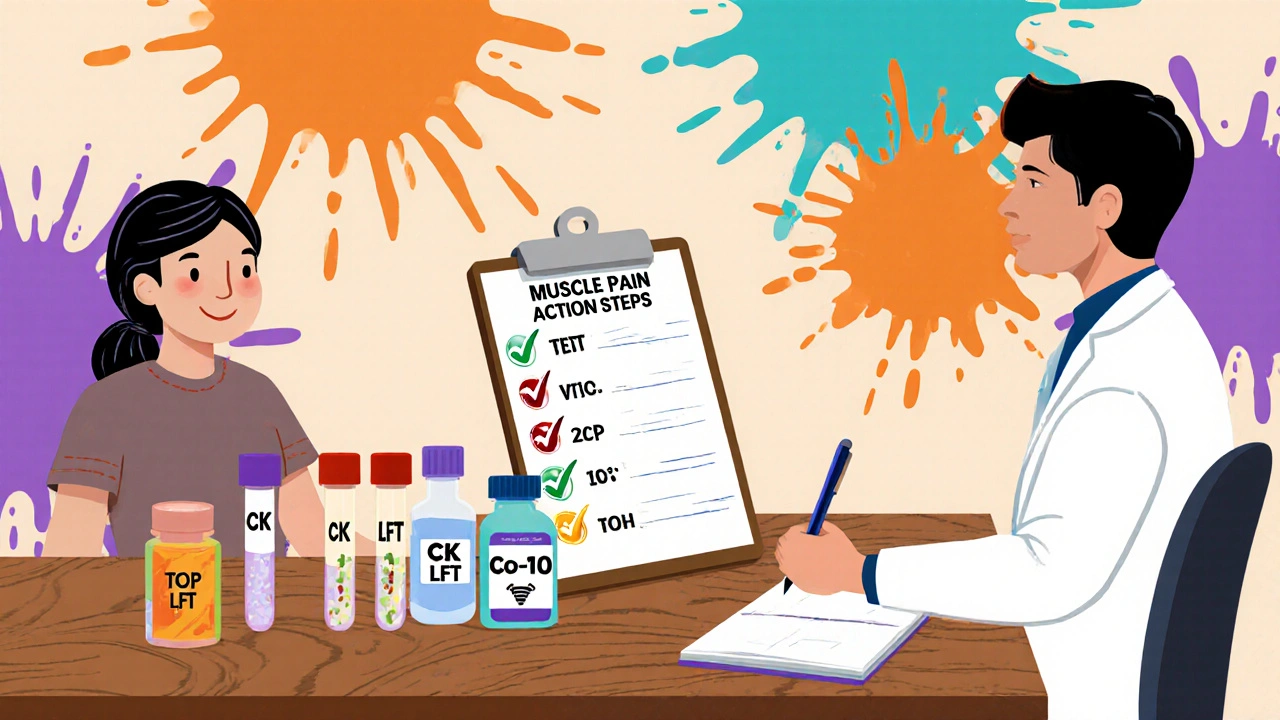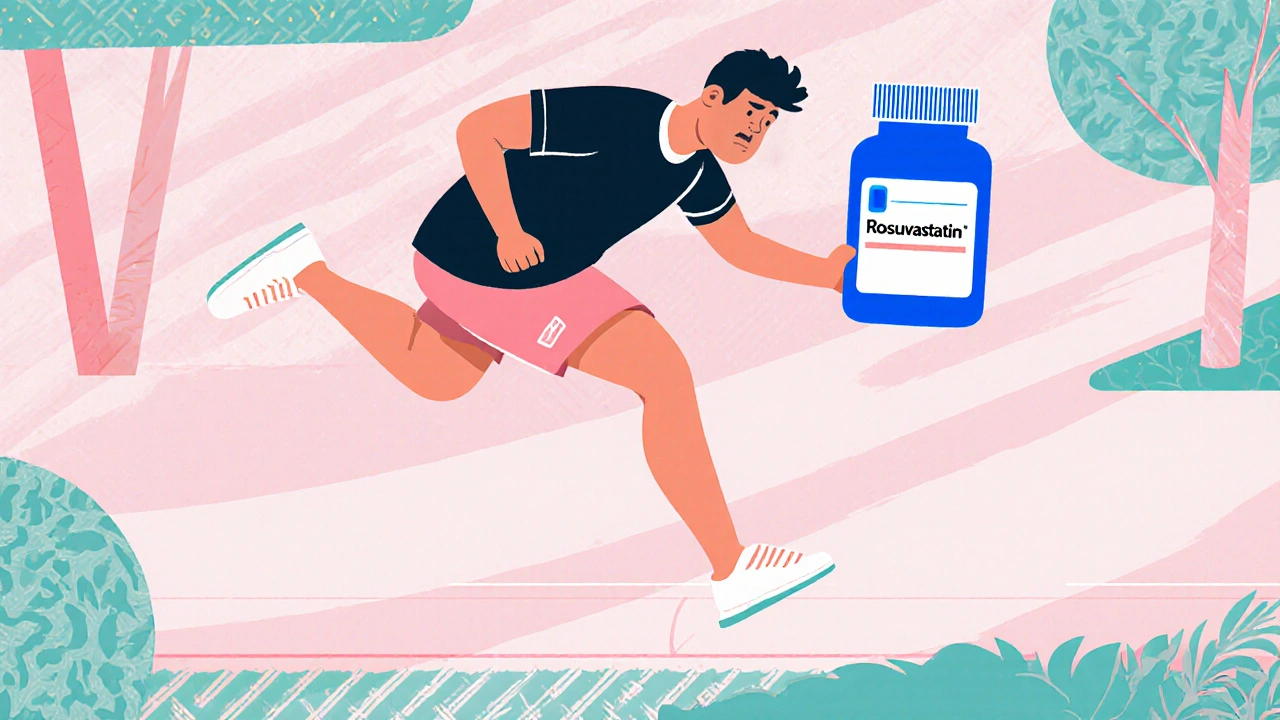Rosuvastatin Muscle Pain Risk Calculator
This tool helps you understand your personal risk of experiencing muscle pain while taking rosuvastatin. Based on clinical data, your risk is calculated using factors like age, dose, and other health conditions.
Your Muscle Pain Risk Assessment
Recommended Actions
Ever wondered why a pill that’s supposed to keep your heart healthy can leave you sore after a jog? Rosuvastatin is one of the most potent cholesterol‑lowering drugs on the market, but a common complaint is muscle pain-sometimes called myalgia or the broader term SAMS (statin‑associated muscle symptoms). This guide walks you through what triggers the ache, who’s most likely to feel it, and practical steps to stay on track without ditching your prescription.
Rosuvastatin is a synthetic HMG‑CoA reductase inhibitor (statin) that reduces low‑density lipoprotein (LDL) cholesterol by blocking the enzyme responsible for cholesterol synthesis in the liver. It was approved by the Australian Therapeutic Goods Administration (TGA) in 2003 and is sold under brand names like Crestor. While its LDL‑cutting power is impressive-often a 45‑55% reduction in a few weeks-some users report uncomfortable muscle sensations.
How Rosuvastatin Lowers Cholesterol
Statins, including rosuvastatin, target the same enzymatic step in the cholesterol‑building line: HMG‑CoA reductase. By inhibiting this enzyme, the liver ramps up LDL receptors, pulling more “bad” cholesterol out of the bloodstream. The result is smoother arterial walls and a lower risk of heart attacks or strokes. In clinical trials, rosuvastatin outperformed many older statins in LDL reduction, making it a go‑to for people with high cardiovascular disease (CVD) risk.
Why Muscle Pain Happens
Muscle pain isn’t a direct chemical burn from the drug; it’s more of a downstream effect. The leading theories are:
- Co‑enzyme Q10 depletion: Statins lower levels of this mitochondrial antioxidant, which can hamper energy production in muscle fibers.
- Altered muscle cell membranes: Reduced cholesterol in cell membranes may make them more fragile.
- Genetic predisposition: Variants in the SLCO1B1 gene affect how quickly the body clears rosuvastatin, leading to higher blood levels and more side effects.
When muscle cells are stressed, they leak an enzyme called creatine kinase (CK) into the blood. A raised CK level can point to muscle injury, although many people with mild myalgia have normal CK.
Who’s Most at Risk
Not everyone on rosuvastatin feels sore, but certain groups have a higher chance:
- Older adults (especially over 65) - muscle mass naturally declines, making fibers more vulnerable.
- People on high doses (20 mg or more) - the dose‑response curve shows more side‑effects at higher intensities.
- Those with pre‑existing muscle disorders or a history of statin intolerance.
- Patients taking interacting drugs such as certain fibrates, cyclosporine, or even large amounts of grapefruit juice, which can raise rosuvastatin levels.
- Individuals with slightly elevated liver function tests (LFT) - the liver processes the drug, so any strain can amplify side‑effects.

Spotting the Warning Signs
Knowing when to act can prevent a minor nuisance from becoming a serious problem. Keep an eye out for:
- Persistent, dull ache in the thighs, calves, or lower back lasting more than two weeks.
- Weakness that makes it hard to climb stairs or lift objects.
- Dark‑colored urine, a possible sign of muscle breakdown (rhabdomyolysis).
- Unexpected spikes in CK or LFT results during routine blood work.
If any of these appear, jot them down and bring them to your doctor’s attention-not the next time you feel a slight twinge.
What to Do If You Feel Pain
First, don’t panic or immediately stop the medication. Here’s a practical plan:
- Schedule a lab test: Ask for CK and LFT panels. Normal CK (up to ~200 U/L) often means the pain is benign; higher levels need evaluation.
- Check your dosage: If you’re on a high dose, your doctor might suggest dropping to 5 mg or 10 mg and monitoring.
- Review other meds: Make sure you’re not on a CYP450‑interacting drug or excessive grapefruit juice.
- Try a short break: In some cases, a 2‑week “statin holiday” can reveal if the drug is the culprit.
- Consider an alternative statin: Some patients tolerate pravastatin or fluvastatin better because they’re less lipophilic.
Never make changes on your own-talk to your GP, pharmacist, or a cardiology specialist.
Managing Side Effects Without Stopping
If you need to stay on rosuvastatin for its heart‑protective benefits, these lifestyle tweaks can help ease muscle symptoms:
- Co‑Q10 supplements: 100‑200 mg daily has shown modest relief in small trials.
- Gentle stretching and low‑impact exercise: Activities like swimming or cycling keep muscles active without over‑loading them.
- Protein‑rich diet: Amino acids support muscle repair. Think lean meats, legumes, and dairy.
- Hydration: Adequate water helps flush metabolites that may irritate muscle cells.
Tracking your symptoms in a journal can also show patterns-perhaps the pain spikes after intense workouts, suggesting you adjust your training instead of the medication.

Comparing Muscle Pain Rates Across Common Statins
| Statin | Typical Daily Dose | Muscle Pain (% of users) | CK Elevation (>3× ULN) |
|---|---|---|---|
| Rosuvastatin | 10‑20 mg | 7‑10 | 0.5‑1 |
| Atorvastatin | 10‑80 mg | 8‑12 | 0.8‑1.5 |
| Simvastatin | 20‑40 mg | 9‑14 | 1‑2 |
| Pravastatin | 10‑40 mg | 5‑8 | 0.3‑0.7 |
| Fluvastatin | 20‑80 mg | 6‑9 | 0.4‑0.9 |
Notice how rosuvastatin’s muscle‑pain rates sit in the middle of the pack-lower than simvastatin but a bit higher than pravastatin. Dose matters, too; the higher end of rosuvastatin (20 mg) leans toward the upper range.
Quick Checklist: What to Do If You Experience Muscle Pain on Rosuvastatin
- Note the location, intensity, and duration of pain.
- Ask for a CK and LFT blood test.
- Review all current medications and dietary supplements for interactions.
- Discuss dose reduction or a temporary pause with your doctor.
- Consider Co‑Q10, gentle exercise, and protein‑rich meals.
- Keep a symptom journal for at least 4 weeks.
Follow this list, and you’ll have solid data to decide whether to stay the course or switch to another cholesterol strategy.
Frequently Asked Questions
Can rosuvastatin cause severe muscle damage?
Severe damage like rhabdomyolysis is rare-less than 0.01% in large trials-but it can happen, especially with high doses or drug interactions. Promptly report dark urine or extreme weakness to a health professional.
Do I need to stop exercising if I get muscle pain?
Not necessarily. Light, low‑impact activity often helps circulation and can reduce soreness. Avoid heavy lifting or intense cardio until you know the cause.
Is a blood test for CK mandatory?
It’s the most objective way to confirm muscle injury. If pain is mild and brief, some doctors may watch and wait, but a baseline CK is recommended when symptoms start.
Can I switch to a different statin without losing heart‑protective benefits?
Yes. Statins share the same LDL‑lowering mechanism. Switching to a less lipophilic option like pravastatin often eases muscle complaints while keeping cardiovascular protection.
Does grapefruit juice affect rosuvastatin?
Grapefruit mainly impacts CYP3A4‑metabolized statins like atorvastatin. Rosuvastatin is less affected, but large amounts can still raise blood levels modestly, so moderation is wise.
Got more questions? Keep a notebook of what you’ve tried and bring it to your next appointment-your doctor will appreciate the detail.


13 Comments
James Dean
October 19, 2025 AT 17:46Statins are a paradox bringing heart safety while whispering muscle fatigue. The body negotiates each dose as a silent treaty. When rosuvastatin nudges the mitochondria the quiet loss of Co‑Q10 can feel like a subtle ache. Consider the balance as a thought experiment rather than a reactionary panic.
Nicole Boyle
October 20, 2025 AT 21:33From a pharmacokinetic perspective rosuvastatin exhibits a high bioavailability that translates into potent LDL‑lowering efficacy.
Yet the same high affinity for hepatocellular transporters, especially OATP1B1, predisposes a subset of patients to elevated plasma concentrations.
These supratherapeutic levels can perturb mitochondrial oxidative phosphorylation by depleting endogenous coenzyme Q10, a phenomenon well documented in the myopathy literature.
Clinicians frequently observe a dose‑response curve where the incidence of myalgia escalates markedly beyond the 10 mg threshold.
Genotypic screening for the SLCO1B1*5 variant has been advocated as a precision‑medicine tool to mitigate this risk.
In practice, concomitant medications such as cyclosporine or certain fibrates act as potent inhibitors of CYP2C9 and CYP2C19, further amplifying rosuvastatin exposure.
Even dietary constituents like grapefruit juice, though a weaker inhibitor for rosuvastatin compared with atorvastatin, can produce a modest increase in systemic exposure when consumed in large volumes.
From a pathophysiological standpoint the resultant muscle cell membrane destabilization may manifest as low‑grade myalgia without overt CK elevation.
Patients reporting persistent dull ache in the calves or thighs should be evaluated with a baseline CK and liver function panel to differentiate benign soreness from incipient rhabdomyolysis.
The clinical algorithm often starts with a dose reduction – for example stepping down from 20 mg to 5 mg daily – and re‑assessment after a 4‑week interval.
Should symptoms persist, a temporary statin holiday of 2 weeks can serve as a diagnostic maneuver to confirm causality.
Alternative statins such as pravastatin or fluvastatin, which possess lower lipophilicity, may offer comparable LDL reduction with a more favorable myopathic profile.
Adjunctive supplementation with Co‑Q10 at dosages of 100–200 mg per day has shown modest benefit in randomized trials, albeit the evidence remains heterogeneous.
Lifestyle modifications – regular low‑impact aerobic activity, adequate protein intake, and optimal hydration – constitute non‑pharmacologic strategies that synergize with lipid‑lowering therapy.
Ultimately, shared decision‑making anchored in patient‑reported outcomes and objective laboratory data ensures that the therapeutic advantage of rosuvastatin is preserved while minimizing discomfort.
Caroline Keller
October 22, 2025 AT 01:19It’s infuriating how a drug designed to protect us becomes the villain in our own bodies. The silent betrayal of muscle fibers is nothing short of a moral outrage against our trust in medicine. When the doctor says ‘it’s just a side effect’ it feels like they’re dismissing our lived pain. We deserve transparency, not vague reassurances that we’ll ‘figure it out later.’ The pain isn’t a myth; it’s a lived reality that we’re forced to endure.
Felix Chan
October 23, 2025 AT 05:06Hey folks, don’t let the muscle ache scare you off the whole statin thing. The heart benefits are huge and the soreness is usually manageable. Talk to your doc about lowering the dose or trying a short break. A little Co‑Q10 and gentle stretching can make a big difference. You’ve got this!
Rakhi Kasana
October 24, 2025 AT 08:53Let’s be clear: not every patient on rosuvastatin will experience myalgia, but the prevalence isn’t trivial. Older adults and those on high doses have a statistically higher chance. Ignoring these risk factors is a disservice to patient safety. A nuanced approach-dose adjustment, interaction review, and monitoring-should be standard practice.
Sunil Yathakula
October 25, 2025 AT 12:39i totally get how confusing all this can be. if u feel sore just go check your ck levels and let ur doctor know. sometimes just a small dose change can fix things. also try drinking more water and doing light stretches. hang in there u’re not alone.
Catherine Viola
October 26, 2025 AT 16:26It is well documented that pharmaceutical conglomerates have historically minimized adverse event reporting to preserve market share. Consequently, the prevalence of rosuvastatin‑associated myopathy may be understated in the peer‑reviewed literature. Independent post‑marketing surveillance data suggest a higher incidence than the manufacturer’s disclosures. Vigilance on the part of both clinician and patient is therefore imperative.
Leo Chan
October 27, 2025 AT 20:13Sunil brought up a great point about simple lifestyle tweaks. Adding a short daily walk and staying hydrated can really soothe those stubborn muscle aches. It’s all about the little wins.
jagdish soni
October 28, 2025 AT 23:59While the anecdotal counsel is appreciated, let us elevate the discourse beyond pedestrian advice. One must contemplate the ontological implications of pharmacological interference with endogenous bioenergetics, a subject deserving of rigorous scholarly interrogation.
Madhav Dasari
October 30, 2025 AT 03:46Dear community, let me bridge the gap between lofty theory and everyday practice. Your concerns are valid, and the science does not exist in a vacuum. By integrating personalized dosing, vigilant monitoring, and compassionate communication we can transform uncertainty into empowerment. Remember, the journey toward cardiovascular health is a marathon, not a sprint, and each step-no matter how small-counts toward the finish line.
DHARMENDER BHATHAVAR
October 31, 2025 AT 07:33Review CK and LFT before adjusting dosage.
Kevin Sheehan
November 1, 2025 AT 11:19Balance risk and benefit, stay informed.
Jay Kay
November 2, 2025 AT 15:06Statins work, but the muscle pain is real and often ignored.